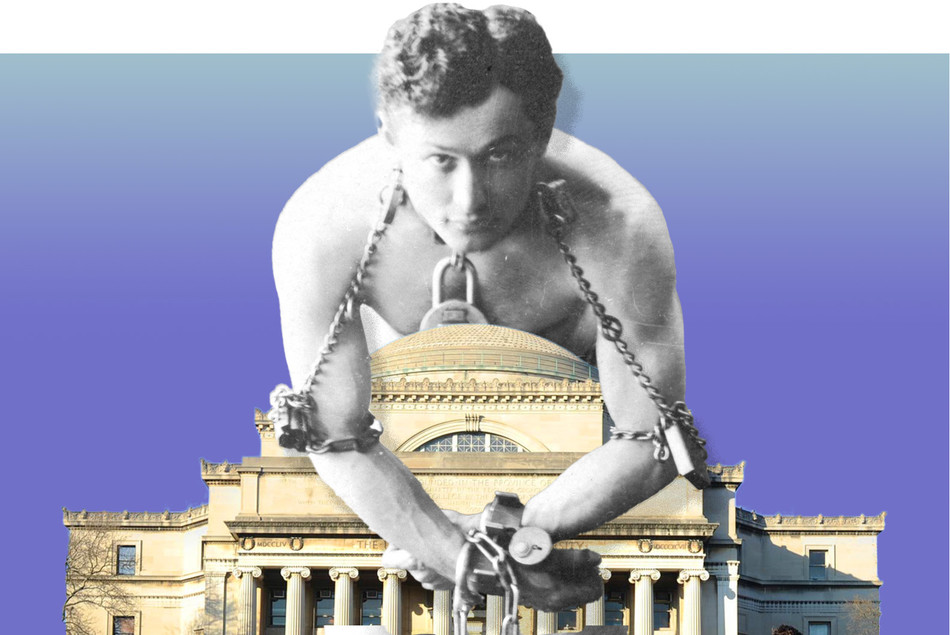When the illusionist and escape artist Harry Houdini died on Halloween 1926, Morris Young ’35VPS was crushed. Young, a seventeen-year-old magic enthusiast, had once seen Houdini perform and afterward had seized the opportunity to show the master his best trick, in which he appeared to suspend himself horizontally in the air. “Houdini was impressed,” says Young’s daughter, Cheryl Young Deknatel ’72BUS, “and he offered to get my father into the Society of American Magicians.”
Intrigued since childhood by sleight of hand and the illusions of magic, Young became an ophthalmologist and raised his two children — Deknatel and her brother, Charles — in a magic-filled home on West 99th and Riverside. “My dad wasn’t a performing magician, but he did a few tricks that would terrify my mother,” Deknatel recalls. “He’d make a lit cigarette disappear by holding it in his mouth. You’ve got to practice, and you can hurt yourself.”
In 1961, Young published, with coauthor Walter B. Gibson, Houdini’s Fabulous Magic, which inspired a generation of magicians. Now in its fourth edition (it was reissued last year by Vine Leaves Press), the book explains many of Houdini’s famous stunts, including the handcuff act (Houdini’s daring variations on this classic trick required hundreds of keys and a special belt) and the straitjacket escape. “To escape a straitjacket, Houdini would dislocate his shoulder,” says Deknatel. “Your body has to be able to do that, and even if it can, it’s painful. But he trained himself.”
Houdini, born Erich Weisz in Hungary (he moved to the US at age four), was one of the early twentieth century’s biggest celebrities, and he had many ties to Columbia. In 1904, toward the end of a triumphant tour of Europe, he bought a brownstone at 278 West 113th Street, just blocks from campus. His lawyer was Bernard Ernst 1905CC, whom he trained in magic. The magician and author John Mulholland, who taught at Columbia, helped Houdini write lectures unmasking spiritualists who conned the public by claiming to communicate with the dead. Houdini had once promised his wife that after his passing he would, if at all possible, contact her from “the other side.” Nearly two years after the fact, Columbia English professor R. F. Dibble, in the Nation, wrote that Houdini’s “complete silence since his death, despite the many attempts made to communicate with him, furnishes perhaps the strongest argument against the spiritualists.”
Young wasn’t the only Columbian to put out a book on Houdini. In 1996, the Pulitzer Prize–winning author and magician Kenneth Silverman ’56CC, ’64GSAS published Houdini!!! The Career of Ehrich Weiss, generally considered the definitive Houdini biography. Alex Stone ’11GSAS, in his 2012 book Fooling Houdini: Magicians, Mentalists, Math Geeks, and the Hidden Powers of the Mind, focused on the science involved in deceiving the eye and mind. “I think there’s much to be gained from reverse engineering a magic trick from the standpoint of cognitive science and psychology,” says Stone, who studied physics at Columbia. “We often don’t realize how ingenious a trick is. Once you learn the method, the illusions may no longer be a mystery, but you can find them even more interesting and beautiful.”
As a collector, Young amassed a trove of magic-themed texts and artifacts. But one was especially dear to him: a pair of Houdini’s handcuffs. He acquired them in the late 1940s, following the death of Houdini’s brother Theodore Hardeen, who had taken possession of Harry’s magic paraphernalia. One day, Hardeen’s widow called Young: she was selling the house and invited him to take what was left. Young went into the cellar, and that’s where he found the handcuffs.
He kept the cuffs on display in his library. As children, Deknatel and her brother were mesmerized by them. In 2024, to mark the 150th anniversary of Houdini’s birth, they will publish Houdini’s Last Handcuffs, a fantasy based on their childhood in 1950s New York.
Young died in 2002 at ninety-three, a much-honored figure in the magic world. His obituary notes that he used a mnemonic system to interpret the numbers of Houdini’s Harlem address, 278 West 113th Street. He came up with “Uncuff We Tie Them” — another reminder that, as with life, there is more to magic than meets the eye.



